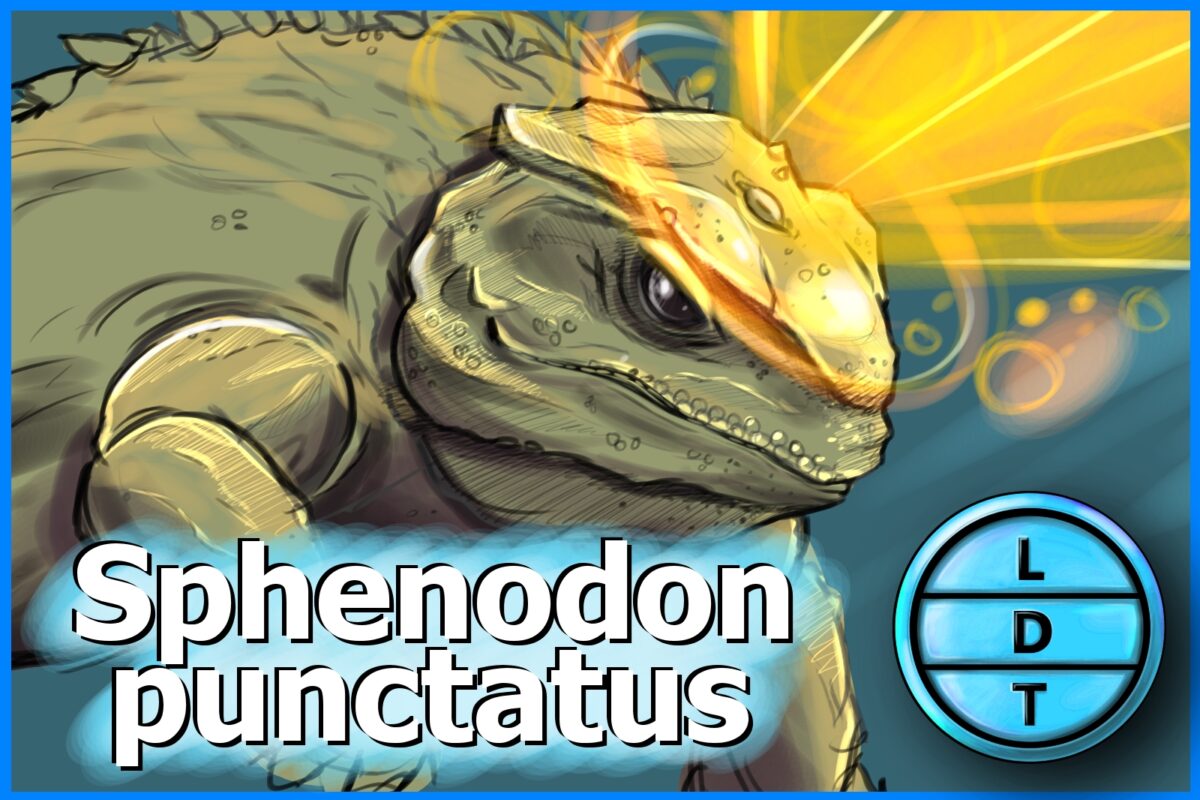“…and today we’re talking about something that looks just like an iguana but it’s apparently not a lizard at all.”
Scattered along the northern coast of New Zealand’s north island is a living fossil that was thought to be extinct: the tuatara. A laid-back lizard with a lazy lifestyle, the tuatara spends most of its time getting some sweet vitamin D in the sun and using the introspective sight of its peculiar third eye. But having insight can help with more than just character development here in Life, Death, and Taxonomy.
Description
- Tuatara are big headed iguana-looking reptiles. They have short, stubby legs and thick scaly bodies.
- They also have a spiny crest along their spines, which is more pronounced in males.
- They come in green and pale grey with that signature countershaded.
Measure Up
Welcome to the beloved Measure Up segment. The official listener’s favorite part of the show! The part of the show when we present the animal’s size and dimension in relatable terms through a quiz that’s fun for the whole family. It’s also the part of the show that’s introduced by you when you send in audio of yourself saying, singing, or chittering the words Measure Up into ldtaxonomy at gmail dot com. We don’t have a new Measure Up intro this week.
- Common house gecko
- Tokay gecko
- Crested gecko
- Leopard gecko
Length
- Males can be 61 cm (24 in) some sources say even longer. Females are shorter, around 45 cm (18 in).
- How many tuataras go into New Zealand’s State Highway 1?
- Hint: The highway is the longest in the country and goes across both of the main islands.
- 3,334,320 tuatara. The highway is 2,033 kilometres (1,263 mi).
Weight
- 1 kg (2.2 lb)
- How many tuatara go into the approximate weight of the participants in the worlds largest performance of the traditional Tahiti Ori dance, if we assume the average weight of participants was 137 pounds (62 kg).
- Hint: The dance literally means Dance of Tahiti, and it’s origins are deeply rooted in Tahitian history. The dance was passed down through an oral history and the dance itself is tied to the oral language of Tahiti. The dance is shared through tourism and through traveling performances abroad. Before the record was secured in Tahiti, it was held in Mexico.
- 178,920. There were 2,982 participants who are around 393,624 lbs.
Fast Facts
Tuatara are native to polynesian islands, New Zealand, and other remote islands of the Pacific. They’ve been driven away from major islands, but they can still be found on smaller less populated islands.
They’re highly protected, so taking one from the wild is very illegal. Zoos have only recently been allowed to take some to display and research. Plus, tuataras are reptilian weirdos that enjoy cool and comfortable temperatures like 60 to 70*F. If temps drop into the 40s, these guys are fine. But if they rise to the 80s, these boys need a window seat or they could die.
Tuatara are competitive little guys and they’ll drive each other away from the best dens and males will fight for mating rights. Since their main method of predation is to sit at the mouth of their burrow and wait for food, a good location is key.
Tuataras live life at island speed. They take 20 years to reach sexual maturity. After mating season, it takes females 7 months to lay their eggs. Then those eggs take a year to hatch. Tuataras may take four years off after they participate in a mating season. But they can live for more than 100 years in the wild.
Through that life, they may enjoy tasty bird eggs, worms, snails, frogs, and insects. Young are vulnerable to predation, even from other tuataras.
Tuatara and rats don’t get along. On islands where rats have established populations, the scaly boys seem to dwindle. Rats are survival experts and eat everything, so they’re able to out compete tuataras. In the 90s, the tuatara on several Polynesian islands were captured and bred in captivity while rats on the island were eradicated. The reptiles were then rereleased.
Major Fact: Third Eye Not-So-Blind
The tuatara is a neat living fossil, but it’s really just an excuse for me to talk about parietal eyes. The parietal eye is a photoreceptive hole in the top of the tuatara’s head. It has a lens, cornea-like structure, retina, rods, the whole kit and kaboodle.
It’s attached to the brain with a weak nerve connection, though the photoreceptors are more similar to those in an octopus’s eyes than vertebrates’.
In fact, many lizards, frogs, fish, and even crustaceans and shrimp have a third eye. So I guess the major fact is that there are quite a few animals out there with three eyes.
The third eye is most pronounced and developed in the tuatara though. It is covered with scales that can make it hard to see, but as a hatchling it’s plainly visible. It’s also not symmetrical like most eyes are, at least in vertebrates, which are mostly symmetrical
There’s a paper by I.R. Schwab that suggests the third eye is a kind of dosimeter (a tool to measure total radiation absorbed. If a Geiger counter is like your speedometer, a dosimeter is like your odometer). It could help the tuatara with its circadian rhythm (day/night cycle).
Other studies suggest that it could allow the tuatara to produce vitamin D, create melatonin for sleep, help with thermoregulation, and even see polarized light to find the position of the sun during cloudy days. And it gets cloudy often in northern New Zealand, if the behind-the-scenes DVDs for lord of the rings are to be believed.
Ending: So bask in the sun, keep up with your daily thermoregulation, and open your mind’s eye like the tuatara here in LDT

